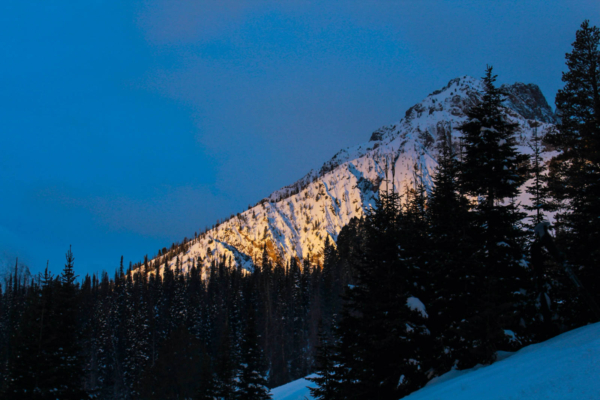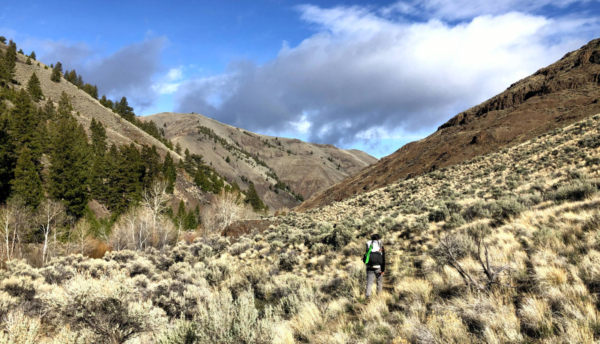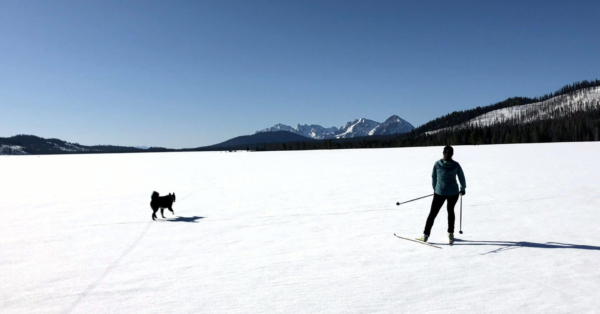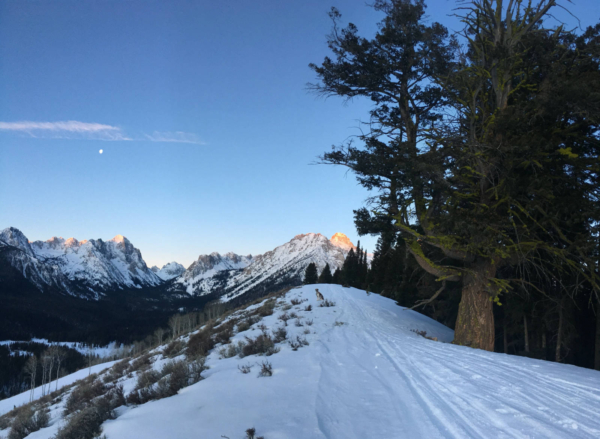Words by Hutkeeper & Hiking Guide Lara Antonello
The world looks a little bit different from our high mountain valley in Stanley, Idaho these days. The pronghorn have replaced snowdrifts on the valley floor. The sandhill cranes echo loudly across the transitioning wetlands. The coyotes echo their praises to a long-awaited spring. Geologic time flashed before our eyes on March 31st (see previous blog post, Faults and Fracture Lines) and took the beloved Arrowhead and summit block of the Finger of Fate with it. People are wearing masks instead of ski goggles and space out for germs instead of avalanche danger.
I went into this blog post with admirable intentions to break the cycle of heart-break day after day in the media. Writers’ block took me by the hand early on and walked me slowly into a field of sage to stare over our dear Sawtooth range. I was going to interview the guides of Sawtooth Mountain Guides (SMG) but what would I ask? I reflected on how I had been growing into this new existence and from that came a series of questions to dive into the complex experience we have all been sharing for months now. After hours of emails and phone calls with my peers laughing over bad wifi, venting about personal struggles, and planning our (someday) post quarantine bbq– in which everyone brings the best and worst of their quarantine cooking– it became obvious that our relationship with the wild world puts a unique lens on this global experience. My hope is that hearing from our guides lends a helpful and relatable perspective. I encourage you to ponder the same questions we did so that we can all rise from this experience with as much passion and empathy as possible.
………………………………………
As guides, our profession revolves around decision making and the outdoors. We love the ways in which we have learned to be human in wild places and want to share it. Our brains are trained to assess and manage risk. We take our work home with us, reviewing daily decisions and pouring over maps to plan routes for adventures months and years in advance. Then the world came to a halt. The necessary end of the winter guiding season came with such abruptness that it left many of us with displaced life momentum. We were working toward personal pinnacles and long-term goals — American Mountain Guides Association (AMGA) courses and exams, gaining fitness for big spring objectives, guiding the biggest winter Iceland has seen in decades — until we weren’t. Energy and enthusiasm suddenly had nowhere to go and we were left searching as bare hands do when pawing into the midnight void for a headlamp. For many of us, the mountains that we see from our bedroom window somehow felt unattainable as we grappled with how to navigate a new variable in the world of backcountry recreation.
So how do we still responsibly connect with a landscape that we love in a way that brings us joy? As guides, we are so used to spending time deep in the backcountry. In dialing back our adventures and spending more time at home, how can we still feel connected with nature and the heart of the landscape that we love so dearly?
For us, it starts and ends with our home mountains. SMG Co-Owner Sara Lundy allowed her mind to wander by reading books about the outdoors that take place in some near and dear mountains in the Frank Church and the Bitterroots. Backpacking Guide Amy David has been following her mother’s example and is observing ecological changes from home. Amy’s mom is an elementary school science teacher who has been teaching her students to pick a “field site” outside or from their window that they can visit every day to observe and record change over time. We are fortunate that our proximity to landscapes we love has offered us the freedom to see our mountains in a different way and pursue simpler backyard adventures that would have otherwise been on the back burner this time of year. Mellow adventures and a sense of calm in the absence of our typical time-crunched schedules has given SVSEF Mountain Awareness Coordinator Lindsay Mann a new sense of freedom to just go out and enjoy things at a more relaxed pace. Birdwatching, mapping future routes, watching houseplants grow, and spending very intentional time in the spring sun may have replaced Ski Mountaineering Courses and big objectives for this winter but these activities did offer a fresh perspective.
I asked our guides: How do you pass the days these days? Do you try to structure them now that life seems to have a bit less structure? If so, how? There are three personalities I came across in our ranks: the person who thrives on a schedule, the person who wants or needs time to process this experience, and the person torn down the middle dancing between the two.
Following structure and timelines are cornerstones in the life of any guide and sometimes these principals sneak their way into our everyday lives. Splitboard guide, Jamie Weeks spoke on why he chose to implement a daily personal schedule to balance out this new normal, “Our lives have been thrown into chaos by this virus, so many things are unknown or out of our control. Order is the exact opposite of chaos and I find order soothing these days.” For many of us, the opposite was necessary (at least at first). Jonathan (JP) Preuss, ski and rock guide, explained how he broke out of the rigid guide routine to find some mental clarity in a slower pace of progress; “ I’m trying to focus on not overloading my schedule and only taking care of a few things a day. It was really hard at first to make that mind shift when guiding is so structured with time control plans and being hyper-focused on managing risk… I’m learning to not let things bother me if they don’t get done that day because there is always tomorrow!” For the parents among us, sneaking in some early or evening recreation after a long day of homeschooling and trying to tucker out kiddos has exposed a fractured version of structure.
What remains true for all of us is that maintaining our strength and fitness has been paramount for our mental health. The goal is to be ready to go as society works toward socially responsible ways to resume backcountry recreation. What have our guides been doing to maintain strength, fitness, and skill sets so that we don’t miss a beat?
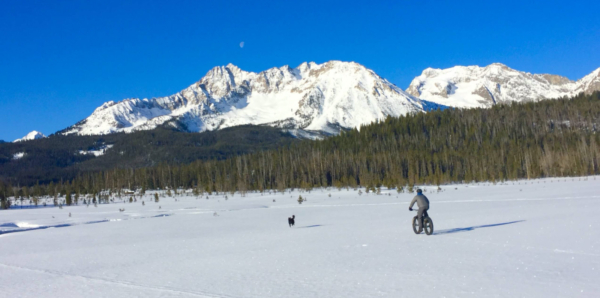
A majority of our guides have taken to doing a version of what they normally would be doing this time of year; “training goes on as before COVID!” says Co-Owner Erik Leidecker. Ski Guide Tanner Haskins has been focusing on his strength and cardio fitness with long mornings on skate skis and long afternoons graveling riding on his mountain bike. Tanner has been staying sharp on rope skills with a livingroom rope set up in plain sight that encourages him to practice knots when he walks by. Everett Coba and Niels Meyer, both Ski Guides, fill their time with some combination of extended backyard adventures, dog walks, and at-home workouts. Ski and Climbing Guides Drew Daly and Matt Scrivner have opted to pursue local miles and practice on their hangboards while some (I’m looking at you JP) have even built mini climbing walls at their homes to improve their strength for the upcoming summer season. Staying sharp has also included taking time to rest. In the heart of the ski season, we are often so focused on upcoming trips and objectives that we don’t have time to acknowledge that we are tired. For some, a combination of some cardio training, yoga, exercising their minds, and resting normally overworked bodies has become the new physical training regiment.
All of us here at SMG will be the first to admit that we miss bigger days far into the mountains that we love so deeply. In addition to that, we miss you all. Guiding the public in the mountains allows us to pass along our love of these sacred wild spaces and support you in your pursuit of adventure. As people who earn our livelihoods by interacting with people and keeping the stoke high, the lack of high fives and hugs has been noticeable. When asked, What do you really miss?, ski and rock guide, Marc Hanselman hit the nail on the head, “[I] miss freedom. I miss being able to choose to go recreate in another place… to hire a babysitter so that my wife and I could recreate together… I miss the certainty of the life we had before – where I had a job and income and could plan on future trips and income.” That is the harsh reality of the guiding industry (along with many other industries) right now. We all want to do the best we can for our communities and loved ones which means that we have to navigate headfirst into the weird and uncharted waters of how to be part of the tourism industry during and in the wake of a pandemic. It’s messy and complicated but maybe our background in risk management and in navigating uncertainty will contribute to the creative solution that society is so desperately searching for.
While it may seem like a cruel inquiry, the reason I asked this question to my peers is that asking myself what I miss and *why* has helped me tremendously during this unique opportunity to pause and reprioritize our lives. A common answer across the board was that we miss our jobs because we love the work that we do. Since our livelihoods are so deeply intertwined with close human interaction, our work is temporarily on hold and this pause presents time to consider aspects of ourselves we don’t explore as frequently. SMG founder, Kirk Bachman said, “I have always been an advocate for guides to develop a [second] piece to their lifestyle. Something which compliments their choice of lifestyle [that will] continue to provide balance and stability.” That balance is important in any profession. As a community of mountain guides, this downtime can be a chance to fill in the blank —Yes, I am a guide. I am also _______ and that sets me apart from my peers.
Creativity is born of adversity. We at SMG have been doing the best that we can to help our communities through social distancing, scaling back our exposure to risk, being on call for local emergency response, running errands for the at risk people in our community and everything in between. Guide Doug Bernard touched on a key way that guides can play a constructive role in our communities moving forward, “I think…trying to be a resource for others has been my goal, to be open to encouraging people to do things outside in the manner that suits their ability and skills and think about how we balance risk and reward to be safe and have fun. Trying to show responsible recreation and at the same time encouraging community out there rather than judging people for behavior.” Helping our communities can be as simple and complex as we have the energy for but it remains true that we need to model the behavior that we hope to see in others.
……………………………….
If you have been into the mountains with me, there is a strong likelihood that you have heard me explain something with an example from the natural world. This lens has developed throughout my lifetime in response to the most profound experiences I have had. These extraordinary times have demanded I look through this lens in order to press on. What is left after two months locked in eye contact with snow-covered bowls and decomposing granite is that we must embody the tenacity of life that returns with the coming of spring. As the ground thaws, the seeds in our high mountain soil begin to germinate. Once germinated. the seed will take on a new form– unrecognizable from the original dormant orb of life buried beneath dark cool soil. The plant will grow from one million subtle variables conspiring together and culminate in flower and fruit… a rebellious display of outward beauty defying all odds. The fruit will die and leave behind an optimistic seed just waiting for a chance to boldly grow again. This is life.
We look forward to getting back out into the mountains with you. Please continue to act in awe, love, and respect toward your communities. Special thank you to the guides of SMG for contributing to this piece. I am so grateful to work and grow with this community through the seasons.

